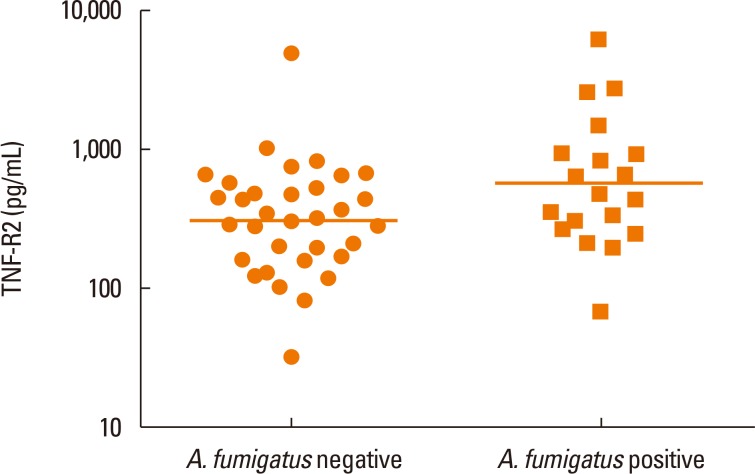Allergy Asthma Immunol Res.
2017 Mar;9(2):177-181. 10.4168/aair.2017.9.2.177.
Sputum Inflammatory Mediators Are Increased in Aspergillus fumigatus Culture-Positive Asthmatics
- Affiliations
-
- 1Institute for Lung Health, NIHR Respiratory Biomedical Research Unit, Department of Infection, Immunity & Inflammation, University of Leicester and University Hospitals of Leicester NHS Trust, Leicester, UK. ceb17@le.ac.uk
- 2MedImmune Ltd, Milstein Building, Granta Park, Cambridge, UK.
- KMID: 2413392
- DOI: http://doi.org/10.4168/aair.2017.9.2.177
Abstract
- Aspergillus fumigatus sensitization and culture in asthma are associated with disease severity and lung function impairment, but their relationship with airway inflammation is poorly understood. We investigated the profile of 24 sputum inflammatory mediators in A. fumigatus culture-positive or-negative moderate-to-severe asthmatics. Fifty-two subjects were recruited from a single center. A. fumigatus was cultured from 19 asthmatics. Asthma control, symptom score, lung function, and sputum cell count were not significantly different between the asthmatics with and without a positive A. fumigatus culture. All of the sputum mediators were numerically increased in subjects with a positive versus negative sputum A. fumigatus culture. Sputum TNF-R2 was significantly elevated (P=0.03) and the mediator that best distinguished A. fumigatus culture-positive from culture-negative subjects (receiver-operator characteristic area under the curve 0.66 [95% CI: 0.51 to 0.82, P=0.045]). A. fumigates-positive culture in moderate-to-severe asthma is associated with increased inflammatory sputum mediators.
MeSH Terms
Figure
Reference
-
1. Global Initiative for Asthma. Global Initiative for Asthma guidelines [Internet]. [place unknown]: Global Initiative for Asthma;2016. 2016 Jun 30. Available from: http://ginasthma.org/.2. Chung KF, Wenzel SE, Brozek JL, Bush A, Castro M, Sterk PJ, et al. International ERS/ATS guidelines on definition, evaluation and treatment of severe asthma. Eur Respir J. 2014; 43:343–373. PMID: 24337046.3. Haldar P, Pavord ID, Shaw DE, Berry MA, Thomas M, Brightling CE, et al. Cluster analysis and clinical asthma phenotypes. Am J Respir Crit Care Med. 2008; 178:218–224. PMID: 18480428.
Article4. Wu W, Bleecker E, Moore W, Busse WW, Castro M, Chung KF, et al. Unsupervised phenotyping of Severe Asthma Research Program participants using expanded lung data. J Allergy Clin Immunol. 2014; 133:1280–1288. PMID: 24589344.
Article5. Ghebre MA, Bafadhel M, Desai D, Cohen SE, Newbold P, Rapley L, et al. Biological clustering supports both "Dutch" and "British" hypotheses of asthma and chronic obstructive pulmonary disease. J Allergy Clin Immunol. 2015; 135:63–72. PMID: 25129678.
Article6. Desai D, Gupta S, Siddiqui S, Singapuri A, Monteiro W, Entwisle J, et al. Sputum mediator profiling and relationship to airway wall geometry imaging in severe asthma. Respir Res. 2013; 14:17. PMID: 23398985.
Article7. Piper E, Brightling C, Niven R, Oh C, Faggioni R, Poon K, et al. A phase II placebo-controlled study of tralokinumab in moderate-to-severe asthma. Eur Respir J. 2013; 41:330–338. PMID: 22743678.
Article8. Bafadhel M, McKenna S, Terry S, Mistry V, Reid C, Haldar P, et al. Acute exacerbations of chronic obstructive pulmonary disease: identification of biologic clusters and their biomarkers. Am J Respir Crit Care Med. 2011; 184:662–671. PMID: 21680942.9. Bafadhel M, McCormick M, Saha S, McKenna S, Shelley M, Hargadon B, et al. Profiling of sputum inflammatory mediators in asthma and chronic obstructive pulmonary disease. Respiration. 2012; 83:36–44. PMID: 21912093.
Article10. Knutsen AP, Bush RK, Demain JG, Denning DW, Dixit A, Fairs A, et al. Fungi and allergic lower respiratory tract diseases. J Allergy Clin Immunol. 2012; 129:280–291. PMID: 22284927.
Article11. Fairs A, Agbetile J, Hargadon B, Bourne M, Monteiro WR, Brightling CE, et al. IgE sensitization to Aspergillus fumigatus is associated with reduced lung function in asthma. Am J Respir Crit Care Med. 2010; 182:1362–1368. PMID: 20639442.12. Agbetile J, Fairs A, Desai D, Hargadon B, Bourne M, Mutalithas K, et al. Isolation of filamentous fungi from sputum in asthma is associated with reduced post-bronchodilator FEV1. Clin Exp Allergy. 2012; 42:782–791. PMID: 22515394.13. Wardlaw AJ, Woolnough K, Pashley CH. Lassoing a chimera: the semantics of allergic fungal airway disease. Clin Exp Allergy. 2015; 45:1746–1749. PMID: 26581852.
Article14. Bafadhel M, McKenna S, Agbetile J, Fairs A, Desai D, Mistry V, et al. Aspergillus fumigatus during stable state and exacerbations of COPD. Eur Respir J. 2014; 43:64–71. PMID: 23598955.
Article15. Public Health England. Investigation of bronchoalveolar lavage, sputum and associated specimens: Bacteriology, B 57, Issue no: 3.1 [Internet]. London: Public Health England;2015. updated 2015 Oct 2. cited 2015 Dec 2. Available from: https://www.gov.uk/government/uploads/system/uploads/attachment_data/file/466668/B_57i3.pdf.16. Pashley CH, Fairs A, Morley JP, Tailor S, Agbetile J, Bafadhel M, et al. Routine processing procedures for isolating filamentous fungi from respiratory sputum samples may underestimate fungal prevalence. Med Mycol. 2012; 50:433–438. PMID: 21961802.
Article17. Brightling C, Berry M, Amrani Y. Targeting TNF-α: a novel therapeutic approach for asthma. J Allergy Clin Immunol. 2008; 121:5–10. PMID: 18036647.
Article18. Lin WR, Chen YH, Lee MF, Hsu LY, Tien CJ, Shih FM, et al. Does spore count matter in fungal allergy?: the role of allergenic fungal species. Allergy Asthma Immunol Res. 2016; 8:404–411. PMID: 27334778.
Article19. Shah A, Panjabi C. Allergic bronchopulmonary aspergillosis: a perplexing clinical entity. Allergy Asthma Immunol Res. 2016; 8:282–297. PMID: 27126721.
Article20. Agbetile J, Bourne M, Fairs A, Hargadon B, Desai D, Broad C, et al. Effectiveness of voriconazole in the treatment of Aspergillus fumigatus-associated asthma (EVITA3 study). J Allergy Clin Immunol. 2014; 134:33–39. PMID: 24290286.
Article21. Denning DW, O'Driscoll BR, Powell G, Chew F, Atherton GT, Vyas A, et al. Randomized controlled trial of oral antifungal treatment for severe asthma with fungal sensitization: the Fungal Asthma Sensitization Trial (FAST) study. Am J Respir Crit Care Med. 2009; 179:11–18. PMID: 18948425.
- Full Text Links
- Actions
-
Cited
- CITED
-
- Close
- Share
- Similar articles
-
- A Case of Allergic Bronchopulmonary Aspergillosis
- An unusual clinical isolate of Aspergillus fumigatus Series from a patient with fungus ball in a cystic change
- A Case of Corneal Ulcer Caused by Combined Infection of Stenotrophomonas Maltophilia and Aspergillus Fumigatus
- The prevalence of allergic bronchopulmonary aspergillosis in asthmatics with positive skin reactivity to Aspergillus fumigatus antigens
- Isolation of Aspergillus phialiseptatus from Sputum of Patient having an Open Negative Cavity with a Mycetoma


